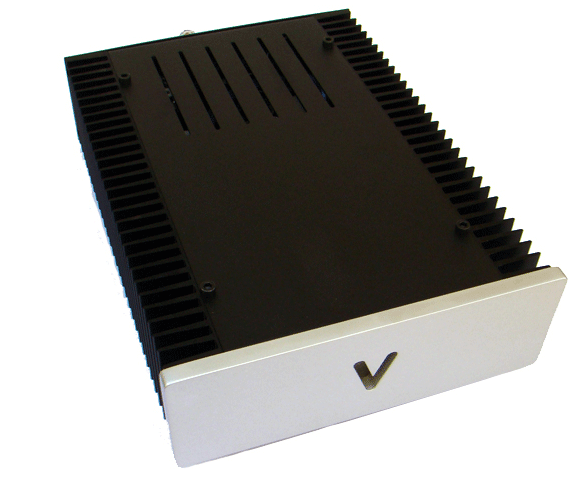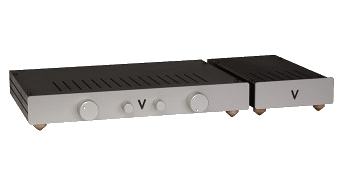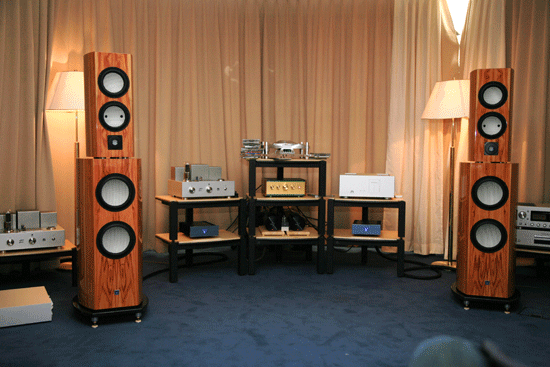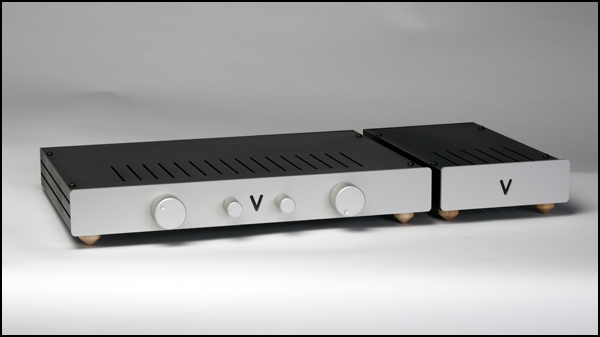The Valvet A3.5 mono block and Soulshine preamplifier
| The Valvet A3.5 mono block and Soulshine preamplifier |
| Giant Killers |
|
|
|
June 2010 |


Alfred Kainz of Highend Electronics has a knack for finding very good products. I say this because Kainz also serves as the sole US importer to Consensus Audio Engineering Conspiracy (loudspeakers) for which I use as a reference. Kainz isn’t just a distributor for high end audio products: he’s a music connoisseur and a lover of the arts. Every now and again, we’d talk mostly music but also some audio-shop. You know, the typical “what’s new and interesting toys” he might know to be of interest. As it just so happened, after the 2009 High End show held in Munich, Kainz told me that he there had been some great enthusiasm for a new line of electronics from Germany called Valvet. Kainz, smartly decided to import the brand into the U.S market. He also mentioned that Consensus Audio Engineering’s designer Stefan Fekete, uses Valvet as his reference amplifiers in trade shows. Needless to say, I instantly became intrigued and wanted to see if my friend and world traveler CP (Clement Perry) knew anything about the Valvet gear since their German-made and he seems to always be on the bleeding edge of unknown fine German gear.

Sure enough, he too heard the Valvets at Munich’s Hifi-Deluxe show powering the two-tier Consensus Audio Engineering Passion loudspeakers (photo above) and in terms of sound, CP wrote in his ’09 Munich report that this room “easily the best sounding…”
With Kainz’s permission (really more like blessings), I was to officially review the Valvet A3.5 mono amps. Better yet, he said he would also send me the Valvet Soulshine preamplifier to audition as well. Oh, Happy Day!
Valvet has been in business for almost for two decades and is located in the north of Germany near Hamburg. Knut Cornils is the founder and the designer behind Valvet products. He has a master’s degree in electrical engineering and Class A amplifiers has been one of his long-time passions. In fact, he built his first Class A amplifier back in 1982. Valvet has since evolved into a distinctive minimalist Class A design, using only the highest quality components: Mundorf gold/silver/capacitors; Vishay resistors, pure silver wiring – and the shortest signal path possible. Cornils does not make hard choices between solid state and tube technology. Rather, his approach takes advantage of both worlds: solid state for power amplifiers and tube magic for preamplifiers. Valvet produces two lines which have the unusual distinction between entry level products he calls “Bricks” and the “Blocks” which serve as his reference line up.
The A3.5 mono amplifiers and the Soulshine preamplifier hail from Valvet’s “Block” line up. They both feature, in terms of size, a minimalist (small chassis), profile design ala Bel Canto and NuForce. Each sport a black anodized aluminum chassis with black or silver front face-plate (Chrome can be had at an extra charge). Style-wise, the streamlined Valvet is a clean and elegant looking design. Its soft glowing logo centered on the face-plate punctuates its well thought-out design. Lastly, for resonance control instead of your standard cheap rubber feet, both the A3.5 and Soulshine come equipped with specially chosen wood for better isolation.
For me, there’s something special about Class A amplifiers. It’s like, once you’ve tasted its power and ultra-finessed handling, you can never go back. Looking back, Class A amplifiers have always sounded better to me. In short: More real. The A3.5 is no different than other Class A designs. The downside is Class A’s inherent poor efficiency rating, power consumption and heat dissipation.

The A3.5 mono-block amplifiers operate in push-pull Class A mode with just a single pair of transistors in the output stage with three gain stages. Cornils believes that the common practice of employing multi transistors in parallel to produce a higher output is detrimental to the sound quality. The Valvet A3.5 produces 50-watts per channel into 8 Ohms (and 80 watts into 4 Ohms). Cornilis states this as a very conservative measurement, as with the entire Valvet line. They have an extremely stable power supply which gives them an excellent ability to deliver current. I can assure you the A3.5 sounds more powerful than its specified power rating. The A3.5 uses a 300VA toroidal transformer and a surprising 100,000 microfarads of filtering for a stable power supply with no capacitor in the signal path of the amplifier. Available outputs (standard) include balanced (XLR) and unbalanced (RCA).

The Soulshine Line Pre-amplifier’s designer uses a tube design with a separate power supply. Note: Soulshine has recently upgraded its toroidal transformer from 50VA to 100VA. According to the Valvet’s this improves the stability and performance. The On/Off switch is located on the separate power supply. The Soulshine uses ECC802S and ECC99 tubes in a dual directly-coupled stages tied into one circuit with the support of only a single Mundorf silver/gold/oil) foil capacitor per channel. Oddly enough, the four control knobs on the Soulshine’s front panel have no labels. Playing around, I found the knob located on the left serves as the input selector, which provides five Inputs: one balanced (XLR), and four unbalanced (RCA)]. For the purpose of this review, I used XLR inputs for this review while the knob located on the far right of Soulshine is the Volume control. The small two center dials adjust L/R Balance Control and Input Sensitivity adjustments. With these gain controls you have the flexibility to adjust the input levels of your source components for the optimal range of the actual Volume control knob, which employs a 24-step attenuator (also available is a new 48-step switch, and a resistor ladder switch built from almost 200 Vishay resistors which is said to provide greater transparency than the stock version). The Valvet Soulshine also comes with an optional universal remote volume control.
Let the show begin!
The A3.5 amplifiers and Soulshine Line Pre-amp were a breeze to install. The amplifiers only weigh about 20 lbs each; and the preamp with the separate power supply weighs only about 17 lbs! I could not quite get used to this as my reference Karan Acoustics KSA 450 weighs close to 170 lb. Trust me, it’s no fun trying to muscle the Karan out of a shipping carton and onto an amp stand!
The Valvet A3.5 amplifiers arrived first while the Soulshine arrived six weeks later. I listened to the A3.5 amps with the Karan Reference Dual Mono Preamp until the Soulshine arrived. I let the A3.5 cook for about a month and while burning- in listening to it with a less than critical ear. The more hours I logged on the A3.5 the better it sounded (I would recommend at least a minimum of 200 hours of break in). A half -hour of warm-up is the norm before serious listening sessions begin however, I left the amps on 24/7 to be sure that the burn in was quick and complete.
So how did the Valvet combo sound in my system? From the very first notes on the very first album, it was obvious that the Valvet combo was something special. In our age of hyper-priced imported components, it’s not just good sounding (even at just over $11k) The Valvet components are the real deal regardless of price. This perfectly paired hybrid combo drove my reference Conspiracy loudspeakers effortlessly. And that’s saying a lot considering the A3.5’s 50 watts per rating. Overall, the sound was detailed, allowing background instruments to appear out of a black background. Transparency also improved with bass dynamics possessing more life-like character and authority. Treble energy and extension were natural, yet very extended, without appearing the least bit bright or aggressive. I should also mention lack of grain with regard to this combo registered zero to my ears.

As they say, looks can be deceiving! The A3.5 mono amps reminded me of the amazing boxing champion Manny Pacquiao in that they really pack a punch for their small and unassuming size. The A3.5s might be rated at 50 watts per side, but they pulled off the trick of sounding impressively big with respectable dynamic range. I was able to push the A3.5 amps to play much louder than I thought possible. I threw a lot of stuff at them, from symphonic music to Pink Floyd, and it was smooth sailing. While the A3.5’s bass didn’t quite have the ultimate low-end prowess of the powerhouse Karan KSA 450, it was nonetheless impressive.
The soundstage was superbly rendered as it seemed to extend beyond the speaker’s outer edges and far beyond my listening room’s wall, making my big Conspiracy loudspeakers do a great disappearing act. Listening to the great recording of Herbert Von Karajan conducting, Beethoven’s Symphony N0.5 in C minor OP.67 (DG 413 932-2) was spectacular and very emotional. Maestro Karajan’s rendition was breathtaking and the Valvet electronics were able to scale the dramatics of the full orchestral crescendos. It was easy to listen deep into the recording for details, while the orchestra filled the soundstage quite convincingly. The A3.5’s were able to control the loudspeakers with great authority, preserving all the sudden dynamic shifts. This requires an amplifier with great control and the Valvet A3.5 is surprisingly capable in that very regard.
 One evening I was in the mood for Mozart and I put on my recording of Hilary Hahn and Natalie Zhu’s rendition of the Violin Sonata in F major K. 376(DG B0004771-02). Then, I listened to the String Quartet in D major K.499(“Hoffmeister“) performed by the Chilingirian Quartet CD (CRD 3427). I dimmed the lights and poured a glass of Bordeaux. What can I say! I was in heaven. In this sonata, Mozart places the violin and the piano on the same level. Each instrument displays rich harmonic structures. As I mentioned above, they were detailed and transparent without being bright or aggressive. The combo never sounded transistorized or mechanical. With the Chilingirian Quartet playing the Mozart’s String quartet in D major, the added dimensionality was quite obvious as was a solidity and stability of focus. Subtle details of bowing texture and pitch variation were very apparent and strongly connected me to the music. In head to head comparisons with the Yugoslavian-made, 450-watt Karan Acoustics KSA-450 ($25k) and KAL preamp ($17k), I ultimately preferred the sonic ease and liquidity of Karan components which better had been the case considering how much bigger and costlier this stuff is. The extra helping of wattage from the Karan gives the music more lift and air around instruments, while widening the stage without any exaggeration.
One evening I was in the mood for Mozart and I put on my recording of Hilary Hahn and Natalie Zhu’s rendition of the Violin Sonata in F major K. 376(DG B0004771-02). Then, I listened to the String Quartet in D major K.499(“Hoffmeister“) performed by the Chilingirian Quartet CD (CRD 3427). I dimmed the lights and poured a glass of Bordeaux. What can I say! I was in heaven. In this sonata, Mozart places the violin and the piano on the same level. Each instrument displays rich harmonic structures. As I mentioned above, they were detailed and transparent without being bright or aggressive. The combo never sounded transistorized or mechanical. With the Chilingirian Quartet playing the Mozart’s String quartet in D major, the added dimensionality was quite obvious as was a solidity and stability of focus. Subtle details of bowing texture and pitch variation were very apparent and strongly connected me to the music. In head to head comparisons with the Yugoslavian-made, 450-watt Karan Acoustics KSA-450 ($25k) and KAL preamp ($17k), I ultimately preferred the sonic ease and liquidity of Karan components which better had been the case considering how much bigger and costlier this stuff is. The extra helping of wattage from the Karan gives the music more lift and air around instruments, while widening the stage without any exaggeration.
Duly noted, I really enjoyed my time with the Valvet A3.5 mono amps and Soulshine preamp combination. They are giant- killers in that they provide the ultimate musical bliss without breaking one’s bank account. If you’re looking for that really great sounding system that isn’t stratospherically priced, then look no further than Valvet. I could easily live a good life with this lovely Valvet combination because it allows me that rare wonderful gift: to simply concentrate on the music. What could be better than that? Highly recommended. My choice for the Most Wanted Component award!

![]()
Specifications:
Valvet A3.5 mono amplifier:
Connection: Massive RCA input socket, input impedance 50 KOhm, massive binding-posts for speaker connection, IEC mains socket
Amplification: 50 watts into 8 Ohm, 90 watts into 4 Ohm, Class A
Transformer: 300VA each mono-block
Filtering: 100,000 µF filtering each mono-block
Dimensions: 230 x 80 x 310 mm (9 x 3.1 x 12.2 inches) WxHxD each mono-block
Case: Aluminum, black powder coated, heat sink black anodized
Front: 10mm black acryl or 10mm Aluminum, black powder coated oder silver anodized
Price: USD $5,590.- per pair mono-blocks
Optional: Eichmann Phonopod $54.00/pair, WBT NextGen jacks $75.00/pair, WBT NextGen bindig posts $180.00/pair, Chrome front $150.00
Valvet Soulshine Preamplifier
Inputs: 5 high level inputs, input impedance 100 KOhm, 1x XLR possible
Amplification: 8x, 18dB, max. output > 50 Volts, output impedance 400 Ohm, 3 outputs OUT1/OUT2/RECOUT, 1x XLR possible
Power supply: external solid state power supply, 100VA
Dimensions: 444 x 50 x 306 mm (17.5 x 2 x 12 inches) WxHxD – Pre-amp; 170 x 50 x 306 mm (6.7 x 2 x 12 inches) WxHxD – power supply
Case: Aluminum, black anodized and powder coated
Front: silver anodized or black anodized
Price: USD $5,590.-
# optional: 48-step resistor-ladder switch $450.00, WBT NexGen $75.00/pair, Eichmann Phonopod $54.00/pair, Chrome front $150.00
Contact
highend-electronics, Inc.
Alfred Kainz
19593 Roanoke Road
Apple Valley, CA 92307
Phone: 760-490-2410
Fax: 760-242-1065
Website:www.highend-electronics.com
Email: office@highend-electronics.com
![]()
Don’t forget to bookmark us! (CTRL-SHFT-D)
Stereo Times Masthead
Publisher/Founder
Clement Perry
Editor
Dave Thomas
Senior Editors
Frank Alles, Mike Girardi, Russell Lichter, Terry London, Moreno Mitchell, Paul Szabady, Bill Wells, Mike Wright, and Stephen Yan,
Current Contributors
David Abramson, Tim Barrall, Dave Allison, Ron Cook, Lewis Dardick, John Hoffman, Dan Secula, Don Shaulis, Greg Simmons, Eric Teh, Greg Voth, Richard Willie, Ed Van Winkle, Rob Dockery, Richard Doran, and Daveed Turek
Site Management Clement Perry
Ad Designer: Martin Perry





Be the first to comment on: The Valvet A3.5 mono block and Soulshine preamplifier